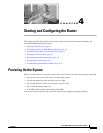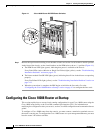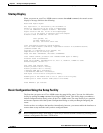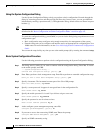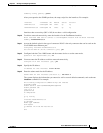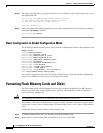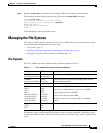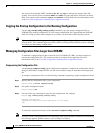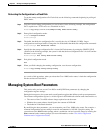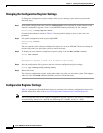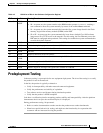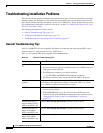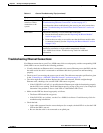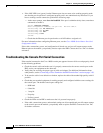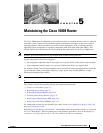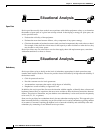
4-9
Cisco 10008 Router Hardware Installation Guide
OL-0659-13
Chapter 4 Starting and Configuring the Router
Managing System Boot Parameters
Relocating the Configuration to a Flash Disk
To run the startup configuration off a Flash disk, use the following commands beginning in privileged
EXEC mode:
Step 1 Copy the current startup configuration to a new location. In the following example, the configuration
file is copied from a TFTP server to a Flash disk in slot 0:
Router# copy tftp://172.16.2.15/example-config disk0:router-config
Step 2 Enter global configuration mode.
Router# configure terminal
Router(config)#
Step 3 The buffer that holds the configuration file is usually the size of NVRAM (512 KB). Larger
configurations need larger buffers. Change the size of the buffer that holds the configuration commands.
Router(config)# boot buffersize 1024000
Step 4 Specify that the startup configuration file is located in Flash memory by setting the CONFIG_FILE
variable. In the following example, the system is told that the boot configuration file is in slot 0 and the
filename is router-config:
Router(config)# boot config disk0:router-config
Step 5 Exit global configuration mode.
end
Step 6 When you finish changing the running-configuration, save the new configuration.
Router# copy running-config startup-config
As a result of this procedure, when you reboot the Cisco 10000 series router, it loads the configuration
file that resides on Flash disk 0.
Managing System Boot Parameters
This section tells you how to use Cisco IOS to modify PRE boot parameters by changing the
configuration register settings.
During the boot process, the system reads a configuration register that defines certain system parameters.
The software configuration register is a 16-bit register in NVRAM used to define such characteristics as
• The source of the Cisco IOS software image required to run the router
• Whether the system software should ignore the contents of NVRAM
• The behavior of the Break function
By modifying the boot parameters, you can customize your Cisco 10000 series router. For example, a
common configuration register setting in some lab environments is 0x2100. Using this setting, the
system boots to the ROM monitor prompt, where a technician can load a specific image by entering the
boot command at the rommon prompt. (For more information, see the Cisco IOS Configuration
Fundamentals Configuration Guide.)



